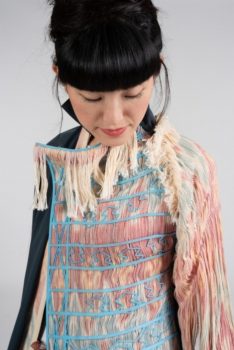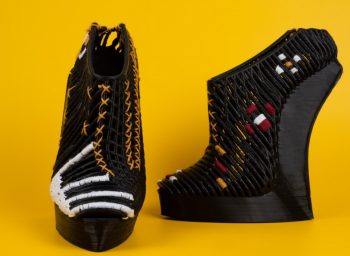Israeli fashion design and, more specifically, 3D printed fashion have been drawing international attention in recent years, not least since Israeli designer Danit Peleg created the world’s first entirely 3D printed fashion collection. Creators in Israel and all over the globe are looking with interest at the limitless possibilities of 3D printed fashion and its multisensorial effects, testing their own imaginative boundaries in a notoriously fickle industry.
At the same time, designers are becoming more aware of the environmental impact of their creative process and some are pivoting to more sustainable options that safeguard their art while supporting an environmentally conscious ecosystem.
One of these designers is Ganit Goldstein, whose creations have embraced 3D printing to create remarkable, and sustainable, works of art. A graduate of the prestigious Bezalel Academy of Arts and Design in Jerusalem, Goldstein has embarked on a path that seeks to reshape fashion through a unique blend of art and technology.
The designer recently launched a collection entitled “Between the Layers”, which was created as a graduation project. The collection is made using 3D printing and consists of seven outfits and six pairs of shoes, which Goldstein designed with the view of “bridging modern technologies and traditional fashion design.” The garments and footwear are made with thermoplastic polyurethane (TPU) and Polylactic acid (PLA).

Ganit Goldstein, Redress Design Award
The unique pieces feature a visual interaction between traditional artistic methods and the dynamic and evolving technologies of artistic expression. Goldstein chose to express this by “fusing additive manufacturing and computer engineering with traditional crafting techniques, such as weaving”, according to a statement.
“My work begins by examining the characteristics of the material, the qualities with which I can work with,” she said. “Working with 3D software gives me the freedom to test which boundaries can be broken. It provides the understanding that the connection to the traditional craft material will create a completely new essence to the original material. For example, the technique of 3D layer printing allows me to re-examine which layers can be added and what new connections I can create.”
Japanese inspiration and the IKAT weaving method

Between The Layers, Ganit Goldstein.
The designer says the inspiration for her “Between The Layers” collection came from her time in Japan, where she took part in an exchange program at the Tokyo University of the Arts and developed her vision of transforming textile waste back into aesthetically captivating objects.
“I was extremely fascinated by the Japanese overall aesthetic and design, their very unique perspective and ways of looking at things,” she tells NoCamels.
In Japan, Goldstein began experimenting with up-cycling and reconstruction techniques, shredding a range of second-hand fabrics and industrial textile leftovers and using a traditional Japanese textile technique called IKAT weaving to create captivating designs. “The IKAT weaving technique enables me to make patterns from the dyeing of the strings before the final weaving process,” she says.
SEE ALSO: Israeli Fashion Design Student 3D Prints Brilliant Collection At Home
Upon her return to Israel, Goldstein started developing a weaving process using an Orginal Prusa i3 Mk3 3D printer and finished off her designs adding hand-woven layers.
As part of the project, the designer collaborated with tech giant Intel to develop an Augmented Reality app that showcases the creative process behind the collection. The designer also paired up with Stratasys for the production of a single pair of shoes, using a Stratasys Connex3 Color 3D Printer for the creation.
Beautiful, and waste-aware
Alongside her art-meets-technology mix, Goldstein has been devoting attention to the creation of garments, shoes and jewelry pieces that are not only beautiful but also sustainable and waste-averse.
“The technique of 3D printing in fashion is a great sustainable tool. It enables designers to experience wide-ranging creative freedom, whilst giving the ability to exercise complete control over what we print and create,” Goldstein tells NoCamels.
Sign up for our free weekly newsletter
Subscribe“With 3D printing, we are able to choose exactly which materials to print and how much we need, as well as the precise pattern we want to obtain, without incurring unneeded waste, a notion that is both empowering and impactful,” she adds.

Furthermore, Goldstein’s overall portfolio of creations is largely reliant on diverse materials and re-usable textiles. In creating her pieces, she uses “an endless variety of materials, some bought at the ‘shuk’ [street markets], some bought at department and hardware stores, some bought at high-end leather and textile stores, and some were just found on the streets,” Goldstein has revealed.
Looking ahead, the designer says she would like to further explore the use of recycled plastics. “Creating designs from recycled plastic is an ever-growing interest of mine and I would like to create a growing number of designs that utilize this material,” she tells NoCamels.
Global recognition
Goldstein has recently been touring the world with her collection of 3D printed clothing and shoes. In September, she was one of 11 designers, and the only Israeli contestant, invited to show her collection at “Redress Design Award 2018” in Hong Kong, the world’s largest sustainable fashion design competition. Goldstein presented a collection of five outfits made with old fabrics, landing the second place.

Ganit Goldstein’s 3D printed shoes. Courtesy
This month, Goldstein participated in the final event of the 2018 “Arts of Fashion” Competition at The Asian Art Museum in San Francisco, CA, where she presented two pairs of shoes, 3D printed with Stratasys, and two outfits, showcasing her combination of craft and technology. Goldstein was once again the only Israeli designer in the competition and the first Bezalel Academy graduate to take part.
SEE ALSO: Israeli Fashion Designer Creates 3D-Printed Clothing, Jewelry That Helps Protect Women From Danger
Goldstein says that “working with the traditional methods, and combining them with new technology is my vision and my inspiration for my future works.”
She predicts that 3D printed fashion “will change the way people design and wear clothes. ‘Personalized’, ‘one-of-a-kind’ pieces that are specifically created for one single person are the future of 3D printed fashion.”
3D Printed Fashion
Israel’s forward-looking innovation in the field of 3D printed fashion is hardly new and some creative ideas by a number of Israeli talents have garnered international attention.
Danit Peleg created the world’s first entirely 3D printed fashion collection, which included five full outfits that took over 2,000 hours to print. Noa Raviv, whose work has been displayed in the New York Metropolitan Museum of Art, created a 3D print collection by manipulating digital images using computer modeling software. Both fashion designers are graduates of the prestigious Shenkar College of Engineering, Design and Art. Late last year, Israeli textile designer Eden Saadon used a 3D printing pen for a lacy lingerie collection.
Earlier this year, NoCamels looked at an emerging, talented Israeli designer, Nitzan Kish, who has been using 3D tech to create uniquely shaped clothing and jewelry with a special purpose in mind – self-defense, specifically in urban environments. Her collection, Me, Myself & I, first released in 2015, features garments that turn into spikes and look like modern body armor.
Related posts

Rehabilitation Nation: Israeli Innovation On Road To Healing

Israeli High-Tech Sector 'Still Good' Despite Year Of War





Facebook comments